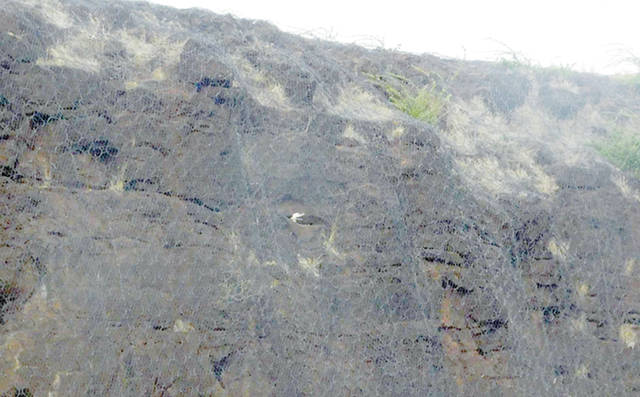WAIMEA — On daily drives through Waimea Canyon, Jay Gardner keeps seeing white-tailed tropicbirds stuck in a cliffside fence meant to keep rocks at bay from the road and houses below.
A local fisherman, Gardner values migratory seabirds and he’s on a mission to save as many of them as he can.
“The tropicbirds, they nest in that (rock) wall and they’ll hold onto the same nest for 15 years,” he said. “Right now it’s nesting season and around noon they come in to feed their young and they get stuck.”
The white birds can be seen against the black rock backdrop, tangled in the chainlink, ring-net drapery system that’s situated along the road in Waimea Canyon.
In mid-September, Gardner got binoculars and counted five adult birds stuck in the fence.
“There are adult birds and baby ones stuck in there,” he said. “It’s obvious.”
The state isn’t oblivious to the situation; representatives of the Department of Land and Natural Resources said DLNR is aware that birds get stuck in the fence.
“We are, of course, concerned about any wildlife that are being impacted by this fence,” said DLNR spokesman Dan Dennison. “Department engineers are consulting with department wildlife experts on what, if anything, can be done to reduce bird mortality at this site.”
White-tailed tropicbirds, or koa‘e kea, are mostly white with black markings along their wings and the base of their long, thin tail feathers. According to the Hawaii’s Comprehensive Wildlife Conservation Strategy, six subspecies of koa’e kea are recognized; only one breeds in Hawaii.
They fish by plunge diving from 15 to 20 meters above the water. While not much is known about their diet, they do like to eat flying fish, according to state research.
Nests are typically tucked in cliffs, caves and tree hollows. Breeding occurs March through October. One egg is laid per season and both parents tend to the chick.
Current data suggests white-tailed tropicbird chicks breed after the fourth year, according to the Comprehensive Wildlife Conservation Strategy.
The Hawaii koa‘e kea population is estimated at 1,500 breeding pairs, with most in the Southeastern Hawaiian Islands, according to the Kauai Endangered Species Recovery Project.
Worldwide population is estimated at less than 200,000 breeding pairs. While the birds aren’t listed as threatened or endangered, they are susceptible to nest predation by rats and feral cats and habitat destruction.
The state does have a plan for management of the species, which is outlined in the Hawaii Wildlife Conservation Strategy. That includes things like predator eradication and control, habitat management and population surveys.
White-tailed tropicbirds getting stuck in the Waimea Canyon fence has been ongoing. Dennison said the state previously cut holes in the ring net and outer meshing to allow free and safe access to nests.
But Gardner says that’s not working.
“These are migratory seabirds, the ones they’re trying to protect,” Gardner pointed out. “The fence is killing them.”
So now, officials are looking to their wildlife experts for ideas on how to protect public safety as well as the lives of the white-tailed tropicbirds.
“This fence was constructed to protect public safety and that remains the highest priority,” Dennison said. “DLNR will explore other options and is saddened by any loss of birds, but again, protecting public safety at this location is the highest priority.”
•••
Jessica Else, environment reporter, can be reached at 245-0452 or jelse@thegardenisland.com.






To “protect public safety” move the road and take down the fence.
Here we go again. Some Haole from the mainland thinking the birds more important then the people’s safety. Clown. Natural selection if the birds can’t figure it out tuff